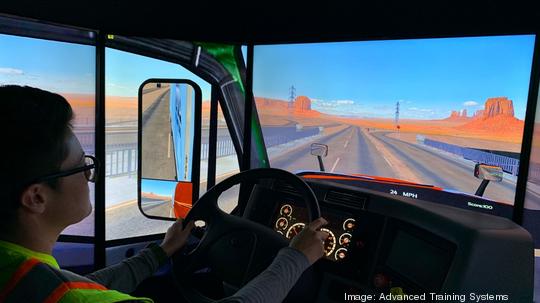
Before commercial truckers get behind the wheel of a big rig on a public road, they’ve undergone hundreds of hours of training to earn their Commercial Driver’s License. St. Petersburg-headquartered company Advanced Training Systems aims to make that training process safer and smoother through simulators and virtual reality.
ATS was founded in 2008 by people from three distinct areas of experience. Jim Voorhees developed driver training software using computer based training. Reginal Welles and Enrique Mar Jr. brought engineering experience related to building the physical systems. John Kearney, the ATS’s current CEO, brought his experience running Roadmaster Drivers Schools.
“The ownership of ATS was composed of the three key disciplines that are required to accomplish the best training results,” said Kearney.
From the simulation software to the physical system and driver training, he said the company covered all necessary bases to prepare students for driving on the road.
”Students should be able to go from the simulation to the real truck, get in it and drive,” he said.
Simulators are just one part of a multi-faceted training approach that also includes classroom courses, computer based training and driving a real truck in the field. ATS offers about six models that recreate the interior of the vehicle the student is training to drive, said Kearney. Those vehicles can include small and large trucks, last-mile delivery vehicles, and vehicles for military and law enforcement.
“They will have a dashboard with real switches and gauges that are on the real vehicle, the seat, steering wheel and pedals are from the real vehicle and the screens the driver sees would give the driver the same experience and the same view that would be experienced in the real vehicle,” Kearney said.
Recreating what a student would experience on the road is critical, said Kearney.
“Learning that is not accurate to the experience in the real vehicle will produce improperly trained drivers who have accidents,” he said. “If the simulator doesn’t tell you exactly what would happen in a real truck, then you’re training wrong.”
Accurate simulations have real world consequences. For many students, the first time they experience hazardous conditions such as rain or snow is in a simulator, so Kearney stressed the importance of depicting those conditions realistically.
“If you’re driving a truck over ice, there’s no way to train an individual how to manage that scenario except in a simulator,” he said. “If you wreck the vehicle and kill some people [on the road], that’s not good. You have to have the exact same feeling you’d have in a real truck in the simulator.”
Kearny said simulation will continue to play a greater role in society, particularly when it comes to training employees.
”The future is going to involve simulation,” he said. “You’re going to see more simulations for training staff how to handle customers and in every other area of business. Young people in this country are already familiar with simulation. They’re playing games using simulation. If you don’t use simulation, young people will probably think you aren’t with it.”
In light of the coronavirus lockdown, ATS has offered its pre-trip application to driving students for free. The application walks trainees through things like pre-trip checklists, basic control skills exam and a road skills test







